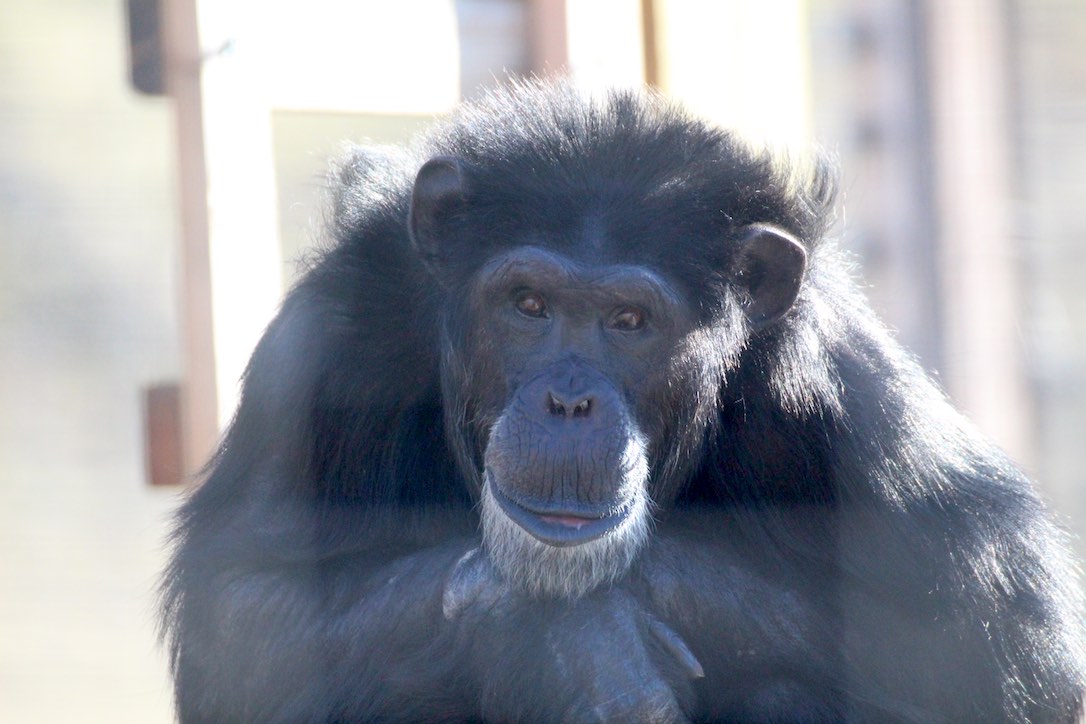With the right camera lens and the right distance, we can “focus through” the fencing that surrounds the outdoor habitats so the fencing disappears or turns into blurs in the foreground.

It’s a trick of the camera. The fencing doesn’t actually go away.

But our eyes perform the same trick. This is roughly where Willy B was looking in the photos above and exactly what that hillside looked like to my eyes too.

We love sharing the sanctuary with loyal supporters and new interested folks too. One comment that people often make when they see a video from us for the first time on Facebook or Instagram is that the chimpanzees shouldn’t be indoors or “in a cage.”
I tried to answer this years ago in this blog post, but I felt it needed an update.
It is helpful to begin as that post did with the image of the type of cages that many of the chimpanzees at CSNW spent the majority of their lives:

That is a cage.
At the sanctuary, there is also caging.

Caging makes people uncomfortable. They want to see chimpanzees outside “where they are meant to be.” They want to imagine that they are free and close to nature.
I’m not immune to it myself.
Just yesterday, I noted what a lovely afternoon it was and tried to implore Jamie to go outside. The voices of my parents echoed in my head as I said, “you should be outside, it’s beautiful.”
When my parents issued similar sentiments, I’m not sure if I ever responded out loud “well then why aren’t you outside?” If Jamie could speak, she would have been right to ask me the same question. She was perfectly happy making a nest by the window in that moment.
We all have individual preferences, and how we want to spend our time can change from one moment to the next. The chimpanzees are the same.
They like different spaces for a multitude of reasons. I hope the video above illustrates both the utility of caging and also how the chimpanzees might view it differently than we do; without all of the symbolism that we humans put on it.
It took us a little more than three years from the time Negra, Burrito, Jamie, Foxie, Missy, Annie, and Jody arrived to give them Young’s Hill – their two-acre habitat surrounded by double electric fences.
In those three years, the chimps were not unhappy. They played, foraged, nested, and spent lots of time in the indoor/outdoor greenhouse.
We knew they should have more, and we wanted to see them truly “outside.”
I can’t imagine Jamie not having Young’s Hill now. She loves it. She owns it.
Negra, on the other hand, can take it or leave it. Seeing her outside in the spring, though, still takes my breath away.

We can’t get inside the heads of the chimpanzees. We can’t ask them what they are thinking. But we can observe them and watch where they choose to spend their time and how they utilize different spaces.
We can (and should) do things to encourage them to GET OUTSIDE, but it’s worth asking ourselves if we are doing that for their sake or for our own – to fulfill the vision we have of what chimpanzees in captivity should be doing instead of what they want to be doing.
These chimpanzees cannot live in the wild. Our job is to give them the best possible captive life possible, with lots of choice and variety, based on their individual needs, personalities, and quirks.
We’ll continue to blur the fencing out of some photos and put the cameras up to the caging for an unobstructed view, but it’s not because we want you to forget that it’s there; it’s so you can fully see the unique and wonderful chimpanzees who are choosing to do whatever they are doing in the moment when the camera shutter closes.





